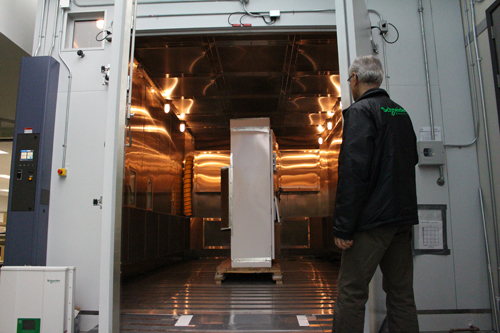Five Innovative Reasons to Invest in Solar Research & Development
 Electricity, the printing press, televisions, the iPod. Where would we be without technology and innovation?
Electricity, the printing press, televisions, the iPod. Where would we be without technology and innovation?
Technology has changed the way humans live and behave; taking us from writing in ink by candlelight to texting by our LED bedroom lamps. Innovation has the ability to make incredible leaps and bounds, revolutionizing industries at lightning speeds.
In 1976, the cost of solar cells was a whopping $76.67 per watt. Last year, the price was $0.74 per watt. Solar is now 99% cheaper than it used to be.*
With such steep falls in prices and increases in accessibility, it’s expected that the solar market will undergo yet another phase of consolidation. The merger, acquisition, and fall of some energy companies have already been seen in the solar market. And, the trend isn’t subsiding anytime soon. In the next five to 10 years, there will likely only be a handful of major solar players left on the panel side of the business, as well as on the power conversion side.
In this ever-changing landscape, companies may feel a natural instinct to tighten their belts. Often times, research and development (R&D) efforts are one of those expenses that are the first to go.
But, here are five reasons why future leaders are investing in innovation now...
1. R&D is a good for business
R&D investment is proven to give a higher rate of return—even up to three times higher than capital investment alone in some cases.
In 2010, The Bureau of Economic Analysis released findings that the United States Gross Domestic Product (GDP) would have been, on average, 2.7%, or $301.5 billion higher between 1998 and 2007, if only R&D spending were treated as investment in the US national income and product accounts (www.bea.gov).
When companies invest in research and development efforts, it signals their commitment to the generation and commercial application of a product. Suppliers, customers, and especially competitors all take note when one company outshines the rest.
To remain competitive in the solar industry, R&D is a critical investment for companies to get noticed, continue to push limitations, and to break conventions.
2. Good products deserve good investments
Ongoing innovation, improvements, and enhancements are integral to providing good products. The core goal of R&D, after all, is to create better market-leading products, so as to serve customers better.
This is where testing and certification comes in—two important steps that help ensure the integrity and reliability of a product. Aside from generating dependability, testing and certification also serves as a means of specifying the technical, legal, and procedural requirements a company must uphold during manufacturing. When considering a long-term, financially heavy investment in a solar power project, which is meant to last years into the future, it seems only wise to select products that are proven to last.
3. Innovation is tied to revenue
In 2013, Thomson Reuters published the Top 100 Global Innovators, which included many familiar names, such as Apple, Google, and Ford (http://thomsonreuters.com).
According to Thomson Reuters, since 2010, the Top 100 Global Innovators on its list have outperformed the S&P 500 in a number of areas: “Specifically, in 2013, they outspent the S&P 500 by 8.8% on R&D, and outperformed the S&P by 4% in annual stock gains, and 2% in year-over-year revenue.”
With innovation comes improved products and, as pointed out by Reuters, increased sales: “This study provides further evidence that innovative organizations—those that secure global patent protection for their intellectual property, continue to push the envelope with new technologies and invest more in R&D—are those that outperform the S&P 500 on virtually every measure of business success.”
4. Investing in good insight
Innovation starts with good ideas. However, those ideas have to come from somewhere. And, to remain competitive, companies not only need creative people, but also people with the commercial and technical know-how, as well as the expertise to turn clever ideas into successful products.
It’s also important to be tuned into the pulse of the industry, and the future of the industry. Creative development might only get a company so far if its ideas are somewhere off in left field and the market’s curving right. Investigating upcoming trends and advancements are significant to market success. For example, exploring hybrid power systems and energy storage solutions, which seem to be the next frontier of the solar industry, are probably an insightful move for the future of solar.
5. Like attracts like
Strong R&D investment can create industry clusters. To put it simply: people who do cool, innovative stuff want to be surrounded by other great people doing cool, innovative stuff—like attracts like. And, to be successful over the trajectory of a career, employees want to be part of a thriving eco-system that has lots of strong opportunities and reputable companies.
R&D encourages like-minded companies to be in the same geographic area, thereby creating a hub. California is a prime example, attracting highly skilled employees in the solar energy market. The state’s economy is actually larger than all but eight other countries (the US included) and, not surprisingly, it’s ranked number one in terms of total solar power capacity. As of the end of 2013, California had nearly 5.7 gigawatts (GW) of installed solar energy (http://cleantechnica.com).
Another example of an industry hub is in British Columbia, Canada, where the clean-tech segment is thriving with over 200 companies, brining inherent value to BC’s economy. Such clusters tend to bring innovation, fast growth, and interesting work—and for every tech job created, another five are created in the broader economy.
Clearly, the right investment and R&D efforts will do more than just increase bottom lines, they create successful economies, communities, and business success. In the end, investing in innovation pays off.
* Read more at http://thinkprogress.org/climate/2013/10/06/2717791/cost-pv-cells-solar-power-grid-parity
Schneider Electric, with its global solar headquarters located in Burnaby, British Columbia, officially opened a $13 million lab dedicated to product testing, as of April of 2014.
Schneider Electric
www.schneiderelectric.com
Author: Pinn Luk
Volume: May/June 2014









.png?r=7769)


